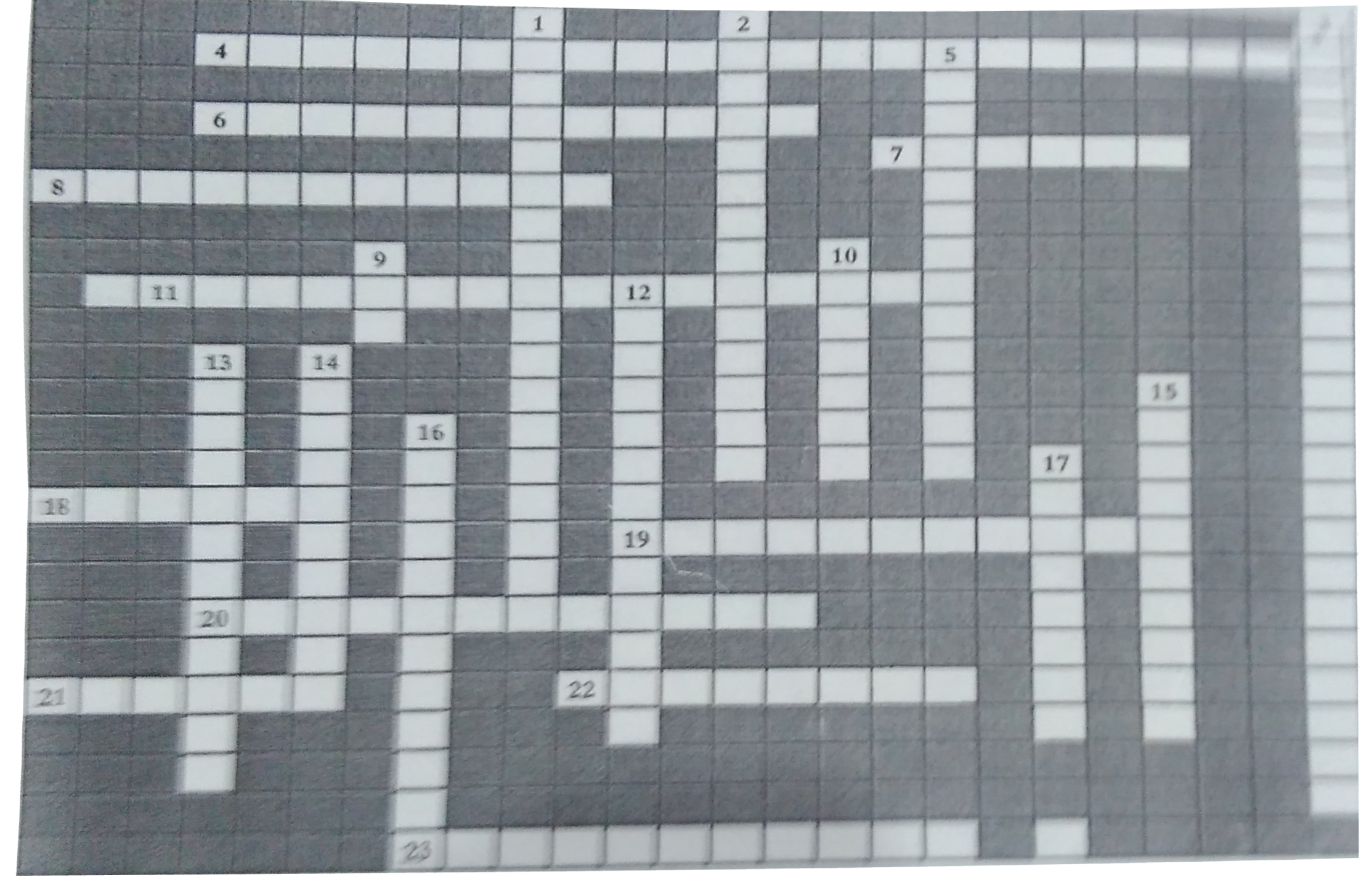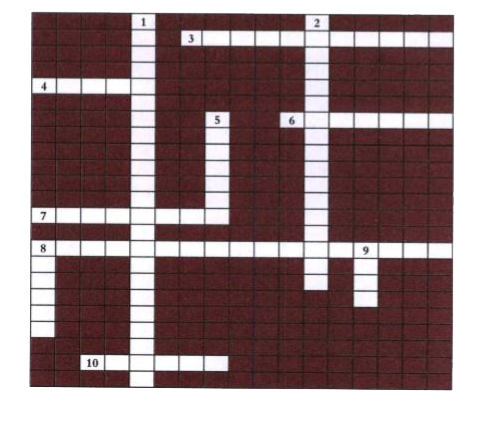
AcrossDown3. Adjustment to habitat1. Plants living in water6. Plant which lives in desert 2. Animals active during night7. Gas released during photosynthesis4. Interaction between biotic and abiotic community8. Organisms which feed on dead animals5. Period between birth and death10. External agent to cause change9. Primary source of energy
The correct Answer is:AcrossDown3. Adaptation1. Hydrophytes6. Cactus2.Nocturnal7. Oxygen 4. Ecosystem 8. Scavengers5.Lifespan10. Stimulus9. Sun
Topper's Solved these Questions
Similar Questions

AcrossDown5. Material that is used for making temporary magnets1. Man-made magnets6. Freely suspended bar magnet takes rest in north-south direction due to2. One of the method of magnetization8. Town in which magnetism is discovered3. Imaginary line perpendicular to magnetic axis and passing through its centre10. Magnet that retain magnetism for long time4. Distance between two poles of a bar magnet7. These poles attract each other9. The point at which maximum magnetic property is concentrated
View Solution
AcrossDown4.Solution containing more amount of solute than its capacity 1. Heat required melting ice to water at 0°C6.Water safe for consumption 2.Addition of unwanted substances to water by human activity7. Useful product generated from cow dung 3. Substance used for the identification of mo1stm 8.Maximum amount of solute to be dissolved pe 100 grams of water 5.Settling down of suspended particles11.Liquid which can dissolve variety of substances 10. Physical property of water having maximum value at 4°C19.Water having medicinal value12.Removal of microorganisms 20.Killing bacteria by producing nascent oxygen13.Heat required to raise the temperature by 1°C21.Gaseous form ofwatcr above 100°C 14. Substante added to hasten the process of sedimentation 22.Homogeneous mixture oftwo or more components15.Passege of water through sand and gravel23. Water from seas and ocean16.Constructions help to preserve rain water 17.Gaseous form of water below boiling point
View Solution
Knowledge Check
To move an airplane through the air, thrust is generated by some kind of propulsion system. Beginning with the Wright brothers' first flight, many airplanes have used internal combustion engines to turn propellers to generate thrust. Today, most general aviation or private airplanes are powered by internal combustion (IC) engines, much like the engine in your family automobile. When discussing engines, we must consider both the mechanical- operation of the machine and the thermodynamic processes that enable the machine to produce useful work. We consider the thermodynamics of a four-stroke IC engine.

Figure shown represents such a cycle which is used in all Internal combustion engines. The figure shows a p-V diagram of the cycle. Using the engine stage numbering system, we begin at the lower left with Stage 1 being the beginning of the intake stroke of the engine. The pressure is near atmospheric pressure and the gas volume is at a minimum. Between Stage 1 and Stage 2 the piston is pulled out of the cylinder with the intake valve open. The pressure remains constant, and the gas volume increases as fuel/air mixture is drawn into the cylinder through the-intake valve. Stage 2 begins the compression stroke of the engine with the closing of the intake valve. Between Stage 2 and Stage 3, the piston moves back into the cylinder, the gas volume.decreases, and the pressure increases because work is done on the gas by the piston. Stage 3 is the beginning of the combustion of the fuel/air mixture. The combustion occurs very quickly and the volume remains constant. Heat is released during combustion which increases both the temperature and the pressure, according to the equation of slate. Slage 4 begins the power stroke of the engine. Between Stage 4 and Stage 5, the piston is driiven towards the crankshaft, the volume in increased, and the pressure falls as work is done by the gas on the píston. At Stage 5 the exhaust valve is opened and the residual heat in the gas is exchanged with the surroundings. The volume remains constant and the pressure adjusts back to atmospheric conditions. Stage 6 begins the exhaust stroke of the engine during which the piston. moves back into the cylinder, the volume decreases and the pressure remains constant. At the end of the exhaust stroke, conditions have returned to Stage 1 and the process repeats itself. During the cycle, work is done on the gas by the plston between stages 2 and 3. Work is done by the gas on the piston between stages 4 and 5. The difference between the work done by the gas and the work done on the gas is the area enclosed by the cycle curve and is the work produced by the cycle. The work times the rate of the cycle (cycles per second) is equal to the power produced by the engine.
Consider that the above diagram represents an ideal such cycle then choose the incorrect statement fora corresponding real cycle.AThe area of the p-V diagram for the real cycle will be lesser than that for ideal cycle.BThe shape of the p-V diagram for the real cycle will be similar to the corresponding ideal cycle.CThe power produced by the engine for an ideal cycle will be greater than that produced by corresponding real cycle.DThe shape of the p-V diagram for the real cycle will not be similar to the ideal cycle.To move an airplane through the air, thrust is generated by some kind of propulsion system. Beginning with the Wright brothers' first flight, many airplanes have used internal combustion engines to turn propellers to generate thrust. Today, most general aviation or private airplanes are powered by internal combustion (IC) engines, much like the engine in your family automobile. When discussing engines, we must consider both the mechanical- operation of the machine and the thermodynamic processes that enable the machine to produce useful work. We consider the thermodynamics of a four-stroke IC engine.

Figure shown represents such a cycle which is used in all Internal combustion engines. The figure shows a p-V diagram of the cycle. Using the engine stage numbering system, we begin at the lower left with Stage 1 being the beginning of the intake stroke of the engine. The pressure is near atmospheric pressure and the gas volume is at a minimum. Between Stage 1 and Stage 2 the piston is pulled out of the cylinder with the intake valve open. The pressure remains constant, and the gas volume increases as fuel/air mixture is drawn into the cylinder through the-intake valve. Stage 2 begins the compression stroke of the engine with the closing of the intake valve. Between Stage 2 and Stage 3, the piston moves back into the cylinder, the gas volume.decreases, and the pressure increases because work is done on the gas by the piston. Stage 3 is the beginning of the combustion of the fuel/air mixture. The combustion occurs very quickly and the volume remains constant. Heat is released during combustion which increases both the temperature and the pressure, according to the equation of slate. Slage 4 begins the power stroke of the engine. Between Stage 4 and Stage 5, the piston is driiven towards the crankshaft, the volume in increased, and the pressure falls as work is done by the gas on the píston. At Stage 5 the exhaust valve is opened and the residual heat in the gas is exchanged with the surroundings. The volume remains constant and the pressure adjusts back to atmospheric conditions. Stage 6 begins the exhaust stroke of the engine during which the piston. moves back into the cylinder, the volume decreases and the pressure remains constant. At the end of the exhaust stroke, conditions have returned to Stage 1 and the process repeats itself. During the cycle, work is done on the gas by the plston between stages 2 and 3. Work is done by the gas on the piston between stages 4 and 5. The difference between the work done by the gas and the work done on the gas is the area enclosed by the cycle curve and is the work produced by the cycle. The work times the rate of the cycle (cycles per second) is equal to the power produced by the engine.
Choose.the correct statement.ADuring the compression stroke, the gas does positive work.BDuring the power stroke the gas.does positive work.CBetween stage 1, 2, the work is done on the gas.DNone of the above.
Match the following columns.
Column-IColumn-IIA. Interkinesis1. Mitotic poisonB. Tubulin synthesis2. S-PhaseC. Disjunction3. Spindle fibreD. Histone synthesis4. AnaphaseE. Colchicine5. DiakinesisF. Terminalisation6. Interphase between meiosis I and meiosis IIG. Nuclear division7. Plant cellH. Cytoplasmic division8. Animal cellI. Centriole9. CytokinesisJ. Cell plate formation10. Karyokinesis
View Solution
AcrossDown3. It is a non-conventional source of energy (Two words)1. It is a domestic source of energy (Three words)4. The SI unit of work is2. Energy stored in a compressed string (Two words)6. It is a form of chemical energy5. Heat energy is measured in__________7. Work done on the body if the displacement of the8. Gravitational potential energy of the body dependsbody is in the direction of force applied on iton mass and_______8. Electricity produced from the stored water in a9. It is a conventional source of energydam is called (Two words)10. This converts light energy into bio-chemical energy
View Solution
AcrossDown4.The cell which cannot be charge1.Electricity produced by water stored at certain height7.The substance which allows electrical energy passes through it 2.Filament works on this effect of electricity8.The property of conductor which opposes current 3.Positive terminal of a cell9.The path of electric energy flow is called5.Negative teminal of a battery6.MCBs are alternative for
View Solution
Across3.It is a non-conventional source of energy (Two words)4.The SI unit of work is6.It is a form of chemical energy7.Work done on the body if the displacement of the body is in the direction of force applied on it8.Electricity produced from the stored water in a dam is called (Two words)10.This converts light energy into bio-chemical energy∣∣ ∣ ∣ ∣ ∣ ∣ ∣ ∣ ∣ ∣ ∣ ∣ ∣ ∣∣Down1.It is a domestic source of energy (Three words)2.Energy stored in a compressed string (Two words)5.Heat energy is measured in________8.Gravitational potential energy of the body depends on mass and ______9It is a conventional source of energy
View Solution
AcrossDown2.The process of coating of thin layer of zine on iron1.The full form of LPG6.The full form of CNG3.Lime water is the solution of 7.The inactive component of air4.Greenhouse gas9.The process of coating of thin layer of tin on iron5.The gas essential for photosynthesis10.Air is considered as6.The green pigment required for photosynthesis is12.The process of burning of a substance in the prence of air8.The slow conversion of iron into its hydrated oxide is 13.With increase in height the percentage of oxygen in air______.10.Carbon dioxide turns lime water11.The gas essential for combustion
View Solution
AcrossDown4.Infinite number of images in formed when two plane mirrors placed1.These are formed due to rectilinear propagation of light5.Magnification of cancave mirror when the object is placed at the centre of curvature2. This mirror forms laterally inverted image7.Example of hot source of light 3.Example of natural source of light 9.Convex mirrror can form this image6. This mirror can form a diminihed virtual image10.Number of images formed when an object placed between two plane mirrors inclined by60∘8.Eclipse formed when earth comes between moon and sun11.Image formed due to convergence of light
View Solution
